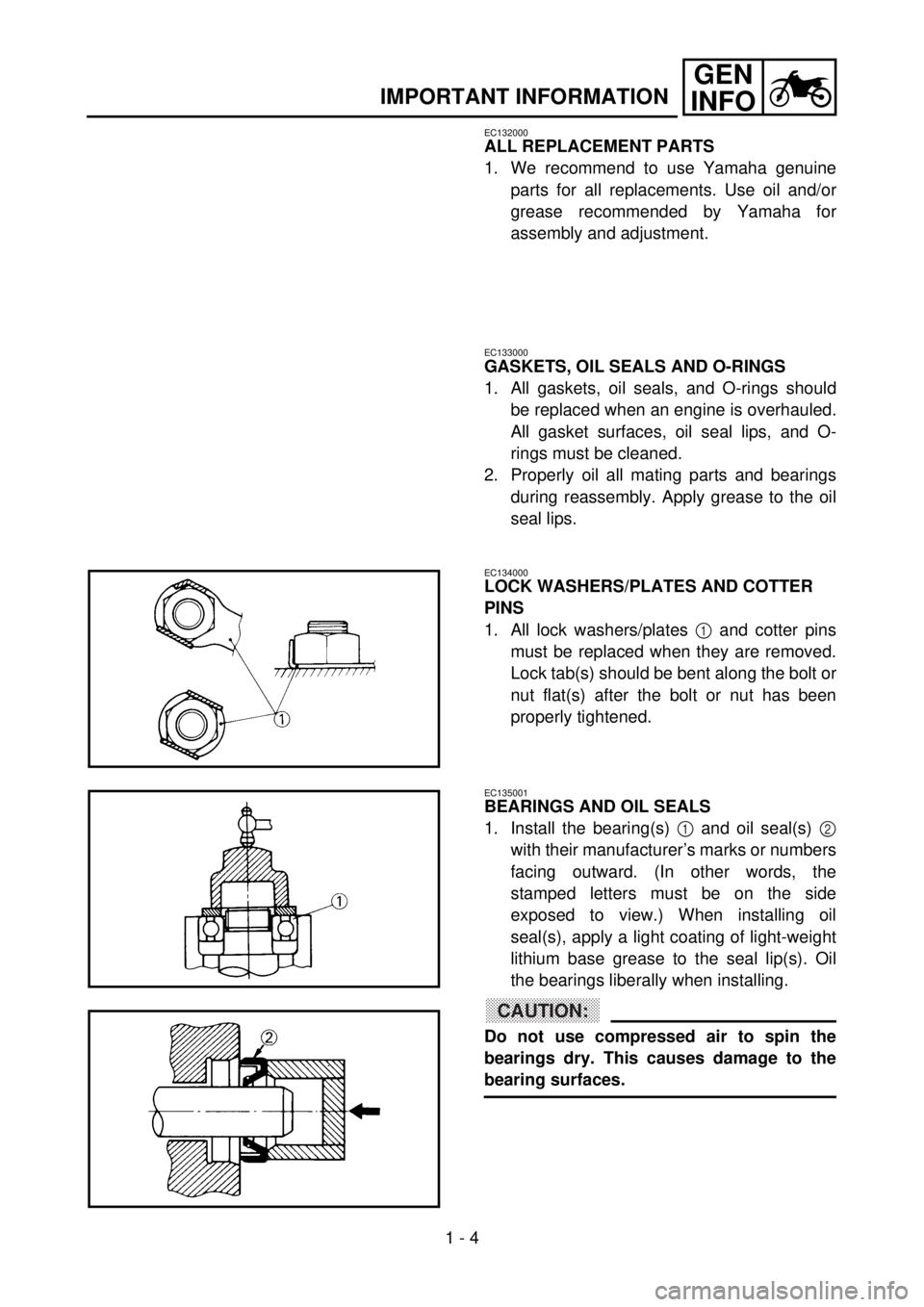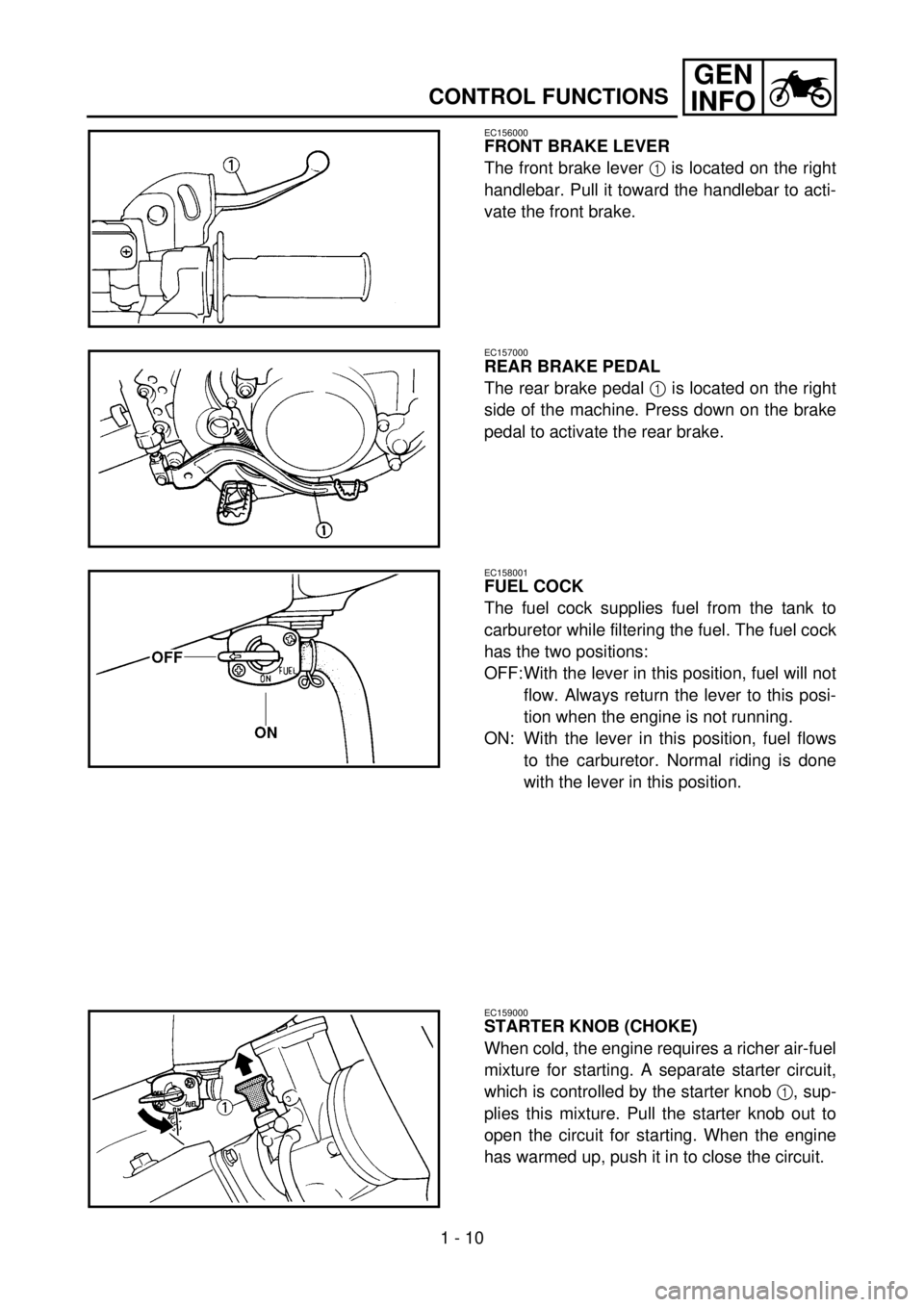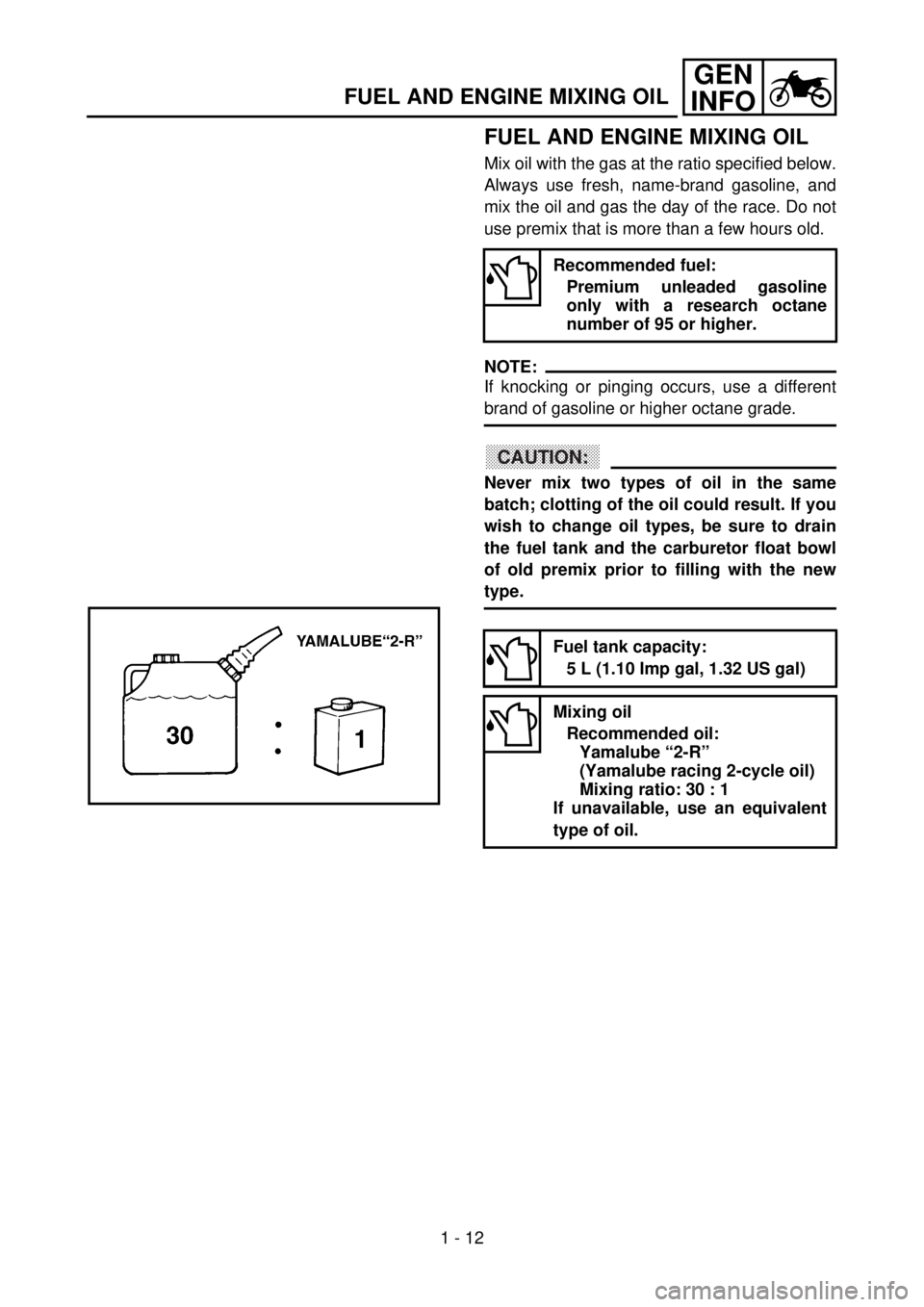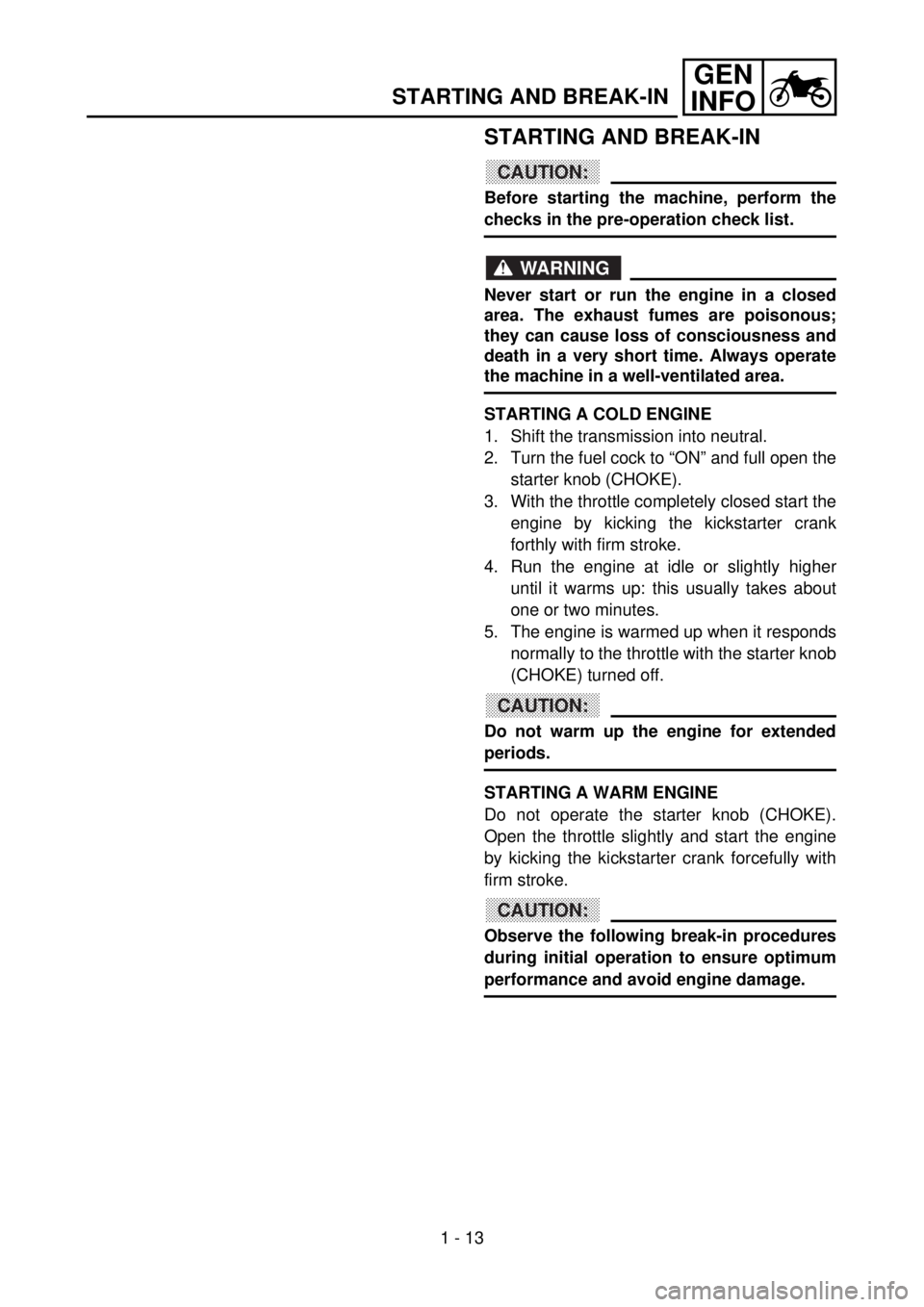engine YAMAHA YZ85 2002 Notices Demploi (in French)
[x] Cancel search | Manufacturer: YAMAHA, Model Year: 2002, Model line: YZ85, Model: YAMAHA YZ85 2002Pages: 504, PDF Size: 40.45 MB
Page 32 of 504

1 - 4
GEN
INFO
IMPORTANT INFORMATION
EC132000
ALL REPLACEMENT PARTS
1. We recommend to use Yamaha genuine
parts for all replacements. Use oil and/or
grease recommended by Yamaha for
assembly and adjustment.
EC133000
GASKETS, OIL SEALS AND O-RINGS
1. All gaskets, oil seals, and O-rings should
be replaced when an engine is overhauled.
All gasket surfaces, oil seal lips, and O-
rings must be cleaned.
2. Properly oil all mating parts and bearings
during reassembly. Apply grease to the oil
seal lips.
EC134000
LOCK WASHERS/PLATES AND COTTER
PINS
1. All lock washers/plates 1 and cotter pins
must be replaced when they are removed.
Lock tab(s) should be bent along the bolt or
nut flat(s) after the bolt or nut has been
properly tightened.
5PA10120
EC135001
BEARINGS AND OIL SEALS
1. Install the bearing(s) 1 and oil seal(s) 2
with their manufacturer’s marks or numbers
facing outward. (In other words, the
stamped letters must be on the side
exposed to view.) When installing oil
seal(s), apply a light coating of light-weight
lithium base grease to the seal lip(s). Oil
the bearings liberally when installing.
CAUTION:
Do not use compressed air to spin the
bearings dry. This causes damage to the
bearing surfaces.
5PA10130
5PA10140
Page 44 of 504

1 - 9
GEN
INFO
CONTROL FUNCTIONS
EC150000
CONTROL FUNCTIONS
ENGINE STOP SWITCH
The engine stop switch 1 is located on the left
handlebar. Continue pushing the engine stop
switch till the engine comes to a stop.
5PA10420
EC152000
CLUTCH LEVER
The clutch lever 1 is located on the left han-
dlebar; it disengages or engages the clutch.
Pull the clutch lever to the handlebar to disen-
gage the clutch, and release the lever to
engage the clutch. The lever should be pulled
rapidly and released slowly for smooth starts.
5PA10430
EC153000
SHIFT PEDAL
The gear ratios of the constant-mesh 6 speed
transmission are ideally spaced. The gears
can be shifted by using the shift pedal 1 on
the left side of the engine.
5PA10440
KICKSTARTER CRANK
Rotate the kickstarter crank 1 away from the
engine. Push the starter down lightly with your
foot until the gears engage, then kick smoothly
and forcefully to start the engine. This model
has a primary kickstarter crank so the engine
can be started in any gear if the clutch is disen-
gaged. In normal practices, however, shift to
neutral before starting.
5PA10450
EC155001
THROTTLE GRIP
The throttle grip 1 is located on the right han-
dlebar; it accelerates or decelerates the
engine. For acceleration, turn the grip toward
you; for deceleration, turn it away from you.
5PA10460
Page 46 of 504

1 - 10
GEN
INFO
CONTROL FUNCTIONS
EC156000
FRONT BRAKE LEVER
The front brake lever 1 is located on the right
handlebar. Pull it toward the handlebar to acti-
vate the front brake.
5PA10470
EC157000
REAR BRAKE PEDAL
The rear brake pedal 1 is located on the right
side of the machine. Press down on the brake
pedal to activate the rear brake.
5PA10480
EC158001
FUEL COCK
The fuel cock supplies fuel from the tank to
carburetor while filtering the fuel. The fuel cock
has the two positions:
OFF:With the lever in this position, fuel will not
flow. Always return the lever to this posi-
tion when the engine is not running.
ON: With the lever in this position, fuel flows
to the carburetor. Normal riding is done
with the lever in this position.
5PA10490
EC159000
STARTER KNOB (CHOKE)
When cold, the engine requires a richer air-fuel
mixture for starting. A separate starter circuit,
which is controlled by the starter knob 1, sup-
plies this mixture. Pull the starter knob out to
open the circuit for starting. When the engine
has warmed up, push it in to close the circuit.
5PA10500
Page 50 of 504

1 - 12
GEN
INFO
FUEL AND ENGINE MIXING OIL
FUEL AND ENGINE MIXING OIL
Mix oil with the gas at the ratio specified below.
Always use fresh, name-brand gasoline, and
mix the oil and gas the day of the race. Do not
use premix that is more than a few hours old.
NOTE:
If knocking or pinging occurs, use a different
brand of gasoline or higher octane grade.
CAUTION:
Never mix two types of oil in the same
batch; clotting of the oil could result. If you
wish to change oil types, be sure to drain
the fuel tank and the carburetor float bowl
of old premix prior to filling with the new
type.
Recommended fuel:
Premium unleaded gasoline
only with a research octane
number of 95 or higher.
Fuel tank capacity:
5 L (1.10 Imp gal, 1.32 US gal)
Mixing oil
Recommended oil:
Yamalube “2-R”
(Yamalube racing 2-cycle oil)
Mixing ratio: 30 : 1
If unavailable, use an equivalent
type of oil.
5PA10540
Page 52 of 504

1 - 13
GEN
INFO
STARTING AND BREAK-IN
STARTING AND BREAK-IN
CAUTION:
Before starting the machine, perform the
checks in the pre-operation check list.
WARNING
Never start or run the engine in a closed
area. The exhaust fumes are poisonous;
they can cause loss of consciousness and
death in a very short time. Always operate
the machine in a well-ventilated area.
STARTING A COLD ENGINE
1. Shift the transmission into neutral.
2. Turn the fuel cock to “ON” and full open the
starter knob (CHOKE).
3. With the throttle completely closed start the
engine by kicking the kickstarter crank
forthly with firm stroke.
4. Run the engine at idle or slightly higher
until it warms up: this usually takes about
one or two minutes.
5. The engine is warmed up when it responds
normally to the throttle with the starter knob
(CHOKE) turned off.
CAUTION:
Do not warm up the engine for extended
periods.
STARTING A WARM ENGINE
Do not operate the starter knob (CHOKE).
Open the throttle slightly and start the engine
by kicking the kickstarter crank forcefully with
firm stroke.
CAUTION:
Observe the following break-in procedures
during initial operation to ensure optimum
performance and avoid engine damage.
Page 54 of 504

1 - 14
GEN
INFO
STARTING AND BREAK-IN
BREAK-IN PROCEDURES
1. Before starting the engine, fill the fuel tank
with a break-in oil-fuel mixture as follows.
2. Perform the pre-operation checks on the
machine.
3. Start and warm up the engine. Check the
idle speed, and check the operation of the
controls and the engine stop switch.
4. Operate the machine in the lower gears at
moderate throttle openings for five to eight
minutes. Stop and check the spark plug
condition; it will show a rich condition dur-
ing break-in.
5. Allow the engine to cool. Restart the
engine and operate the machine as in the
step above for five minutes. Then, very
briefly shift to the higher gears and check
full-throttle response. Stop and check the
spark plug.
6. After again allowing the engine to cool,
restart and run the machine for five more
minutes. Full throttle and the higher gears
may be used, but sustained full-throttle
operation should be avoided. Check the
spark plug condition.
7. Allow the engine to cool, remove the top
end, and inspect the piston and cylinder.
Remove any high spots on the piston with
#600 grit wet sandpaper. Clean all compo-
nents and carefully reassemble the top
end.
8. Drain the break-in oil-fuel mixture from the
fuel tank and refill with the specified mix.
9. Restart the engine and check the operation
of the machine throughout its entire operat-
ing range. Stop and check the spark plug
condition. Restart the machine and operate
it for about 10 to 15 more minutes. The
machine will now be ready to race.
Mixing oil:
Yamalube “2-R”
Mixing ratio:
15 : 1
Page 56 of 504

1 - 15
GEN
INFO
STARTING AND BREAK-IN
CAUTION:
lAfter the break-in or before each race,
you must check the entire machine for
loose fittings and fasteners as per
“TORQUE-CHECK POINTS”.
Tighten all such fasteners as required.
lWhen any of the following parts have
been replaced, they must be broken in.
CYLINDER AND CRANKSHAFT:
About one hour of break-in operation is
necessary.
PISTON, RING AND GEARS:
These parts require about 30 minutes of
break-in operation at half-throttle or less.
Observe the condition of the engine care-
fully during operation.
Page 58 of 504

GEN
INFO
1 - 16
TORQUE-CHECK POINTS
TORQUE-CHECK POINTS
Frame construction
Combined seat and fuel tank
Engine mounting
Steering Steering stem to
handlebar
Suspension Front Steering stem to front
fork
Rear For link type
Rear Installation of rear
shock absorber
Rear Installation of swin-
garm
Wheel Installation of wheel Front
Rear
Brake Front
Rear
Fuel systemFrame to rear frame
Fuel tank to frame
Frame to engine
Steering stem to upper bracket
Upper bracket to handlebar
Front fork to upper bracket
Front fork to lower bracket
Assembly of links
Link to frame
Link to rear shock absorber
Link to swingarm
Rear shock absorber to frame
Tightening of pivot shaft
Tightening of wheel axle
Tightening of wheel axle
Wheel to rear wheel sprocket
Brake caliper to front fork
Brake disc to wheel
Tightening of union bolt
Brake master cylinder to handlebar
Tightening of bleed screw
Brake caliper to bracket
Brake disc to wheel
Tightening of union bolt
Brake master cylinder to frame
Tightening of bleed screw
Fuel tank to fuel cock
NOTE:
Concerning the tightening torque, refer to
“MAINTENANCE SPECIFICATIONS” section
in the CHAPTER 2.
Page 62 of 504

1 - 17
GEN
INFO
CLEANING AND STORAGE
EC1B0000
CLEANING AND STORAGE
EC1B1000
CLEANING
Frequent cleaning of your machine will
enhance its appearance, maintain good overall
performance, and extend the life of many com-
ponents.
1. Before washing the machine, block off the
end of the exhaust pipe to prevent water
from entering. A plastic bag secured with a
rubber band may be used for this purpose.
2. If the engine is excessively greasy, apply
some degreaser to it with a paint brush. Do
not apply degreaser to the chain, sprock-
ets, or wheel axles.
3. Rinse the dirt and degreaser off with a gar-
den hose; use only enough pressure to do
the job.
CAUTION:
Excessive hose pressure may cause water
seepage and contamination of wheel bear-
ings, front forks, brakes and transmission
seals. Many expensive repair bills have
resulted from improper high pressure
detergent applications such as those avail-
able in coin-operated car washers.
4. After the majority of the dirt has been
hosed off, wash all surfaces with warm
water and a mild detergent. Use an old
toothbrush to clean hard-to-reach places.
5. Rinse the machine off immediately with
clean water, and dry all surfaces with a soft
towel or cloth.
6. Immediately after washing, remove excess
water from the chain with a paper towel
and lubricate the chain to prevent rust.
7. Clean the seat with a vinyl upholstery
cleaner to keep the cover pliable and
glossy.
8. Automotive wax may be applied to all
painted or chromed surfaces. Avoid combi-
nation cleaner-waxes, as they may contain
abrasives.
9. After completing the above, start the
engine and allow it to idle for several min-
utes.
Page 64 of 504

1 - 18
GEN
INFO
CLEANING AND STORAGE
EC1B2001
STORAGE
If your machine is to be stored for 60 days or
more, some preventive measures must be
taken to avoid deterioration. After cleaning the
machine thoroughly, prepare it for storage as
follows:
1. Drain the fuel tank, fuel lines, and the car-
buretor float bowl.
2. Remove the spark plug, pour a tablespoon
of SAE 10W-30 motor oil in the spark plug
hole, and reinstall the plug. With the engine
stop switch pushed in, kick the engine over
several times to coat the cylinder walls with
oil.
3. Remove the drive chain, clean it thoroughly
with solvent, and lubricate it. Reinstall the
chain or store it in a plastic bag tied to the
frame.
4. Lubricate all control cables.
5. Block the frame up to raise the wheels off
the ground.
6. Tie a plastic bag over the exhaust pipe out-
let to prevent moisture from entering.
7. If the machine is to be stored in a humid or
salt-air environment, coat all exposed
metal surfaces with a film of light oil. Do not
apply oil to rubber parts or the seat cover.
NOTE:
Make any necessary repairs before the
machine is stored.